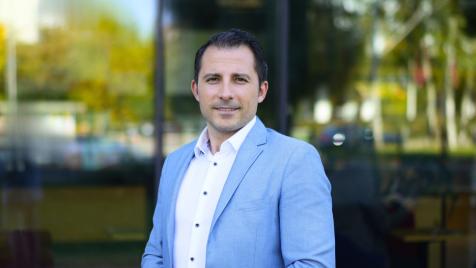Crowdfunding – a Game for Advanced Players
Bulgarian entrepreneurs share the lessons learned from the use of the platforms

© ECONOMIC.BG / Георги Петев
Halfbike
In business, after “I have an idea!” usually comes a plan and the difficult part – how to convince FFF, family, friends, fools, that there is potential in the venture. With the development of digital technology, a low-budget opportunity has emerged for the validation of an entrepreneurial idea – crowdfunding. With it, the potential users are those who support directly out of their wallets non-existing or startup businesses.
Crowdfunding is not a new thing. The first mention of the term appeared at the end of the 20th century, when fans of a British rock group funded its tour through a web-based campaign. The musicians raised USD 60,000.
Today, according to data of The Crowdfunding Centre, quoted by the Statista platform, the number of the platforms for crowdfunding companies is growing, and interest in them is not declining. In 2012, there were 462 platforms in the world, and in two years, their number increased to 1250. In 2016, the value of funds attracted through online campaigns around the world was USD 738.9 million. But crowdfunding is not an easy game – in 2018, only 34 products from millions of campaigns in Kickstarter attracted investments of more than USD 1 million. 57% of the campaigns in the platform have failed.
Crowdfunding is a marketing game for advanced players in which both companies and consumers rely on their instinct for something new and useful and on their sense of commercial tricks in new forms. The platforms are a marketplace like any other – a reusable folding straw is offered together with a project of a replica of Katie Perry’s stage costume, and a bracelet that automatically measures the calories of the food taken, the level of hydration and stress. The first two campaigns succeeded, and the third was rejected as suspicious because of the company’s ownership and the medical evidence for the accuracy of the results.
Crowdfunding works, even if the projects fail – if there are people who would pay almost without giving it a thought for a product, then it has a future. If the campaign does not attract resources, this provides valuable information to its creator – they have to either give up or change the concept of the product.
I met with three Bulgarian entrepreneurs who have learned their crowdfunding lessons and share them.
A few days ago, Martin Angelov of Kolelinia launched a third campaign for Halfbike. He says that in 2015 Kickstarter looked like a platform, “where there were many people open to new ideas, and we hoped the campaign would happen naturally.”
Neven Boyanov from the Tinusaur robotics project has an experience with 6 campaigns on international platforms. “In the winter of 2016, I launched my first campaign on Indiegogo. I managed to raise just over half of what I had set as goal, but more importantly, there was a demand for the product,” he says. “I could say that half of our campaigns were successful, the others – not so much. The important thing is that we have fulfilled our commitments.”
Elena Rapandzhieva, Executive Producer of Zmey Studio, tells about the first campaign of the 2015 Golden Apple project on Kickstarter. “On the one hand, this is an excellent mechanism for checking the public interest, and on the other – at that time we were not in a position to qualify for state funding.” During this campaign, the studio raised 200% of the funds needed and realizes its short film “Legend of the First Kuker Warrior.” In the second campaign for making a 24-minute pilot episode, we did not raise all the funds, but the interest in the project was growing.
All three projects were available on the platforms at a prototype or production ready stage. According to Neven, crowdfunding works for validating an idea or a product in order to start a small-scale production. Martin adds that the main idea is to support causes or ideas that would not otherwise be possible. “In the context of the animation industry (film or gaming), crowdfunding is a step towards big funding. The campaign gives the extremely important added value – it serves as a project advertisement and gathers feedback from the audience,” Elena concludes.
All three of them prepared their campaigns on their own, without expert help, but the preparation was serious. According to Neven, one of the things that can be noticed across most successful campaigns is a good video and a solid warming-up of the potential audience. “Successful campaigns are the ones that lead to expectations, and at the same time, create and maintain a community around the product. The latter, perhaps, plays the most important role in a successful campaign,” Martin says.
Elena mentions the elements that make such a project beneficial: a clear message about the product, a strong cause and a specific purpose, an infectious appeal, a good communication strategy, proven product innovation or a good vision for an art product, and last but not least well-distributed levels of funding and accompanying awards.
“You must invest at least 20% of the amount you hope to raise in advance. It would be completely wrong to press the Start button and wait for the money to start rolling in. The biggest challenge during the campaign is to reach as many people as possible. It always starts with personal contacts. Then come advertising, promotion, participation in events, etc. This is actually a 24/7 work,” Neven adds.
After the hard work of attracting supporters, new challenges are faced. Non-locally oriented products and projects are available on international platforms. The competition is great and your success depends on the innovativeness and usefulness of the proposal. “Kickstarter and Indiegogo have been able to build and engage many enthusiasts who regularly monitor and support emerging campaigns. If you manage to spark people’s interest with your idea, it will not matter where it comes from,” Martin says. Neven reminds of the risk of offering a product “at a very low price and with very nice pictures” on an international platform. “When the time comes for production and delivery, insurmountable problems arise. Sometimes the people behind the projects rather overestimate their capabilities or they have not done their calculations for the production of their product properly, and they are not aimed at consumers,” Neven says.
Elena advises users and investors to read the project description carefully, to envision the details of the preparation, and if something sounds unrealistic – to contact the creators of the campaign directly. Neven adds that platforms carry out more in-depth preliminary interviews with entrepreneurs to minimize the possibility of future failure. “ Crowdfunding is not an online shop. Although I see more and more companies that use it as a tool for generating turnover lately, and this distorts the idea,” Martin adds.
At the end of the conversation, I ask all three when and how the support under the FFF formula turns into a real crowdfunding. Elena says that if the campaign is accompanied by a good media communication, the information about it should go beyond the FFF circle and the funding will come from a wider audience.
“Crowdfunding is just a tool that everyone is trying to use for their needs and purposes. Often, the result is exactly the above formula. There are also occasions when it manages to achieve something good,” Martin adds. Neven ends with a smile that crowdfunding is the reason his hobby turned into a real business and recommends it to anyone who has an innovative but real idea.




